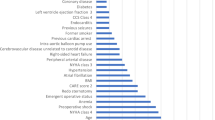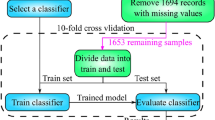Abstract
Background
Acute kidney injury (AKI), a prevalent non-neurological complication following traumatic brain injury (TBI), is a major clinical issue with an unfavorable prognosis. This study aimed to develop and validate machine learning models to predict severe AKI (stage 3 or greater) incidence in patients with TBI.
Methods
A retrospective cohort study was conducted by using two public databases: the Medical Information Mart for Intensive Care IV (MIMIC)-IV and the eICU Collaborative Research Database (eICU-CRD). Recursive feature elimination was used to select candidate predictors obtained within 24 h of intensive care unit admission. The area under the curve and decision curve analysis curves were used to determine the discriminatory ability. On the other hand, the calibration curve was employed to evaluate the calibrated performance of the newly developed machine learning models.
Results
In the MIMIC-IV database, there were 808 patients diagnosed with moderate and severe TBI (msTBI) (msTBI is defined as Glasgow Coma Score < 12). Of these, 60 (7.43%) patients experienced severe AKI. External validation in the eICU-CRD indicated that the random forest (RF) model had the highest area under the curve of 0.819 (95% confidence interval 0.783–0.851). Furthermore, in the calibration curve, the RF model was well calibrated (P = 0.795).
Conclusions
In this study, the RF model demonstrated better discrimination in predicting severe AKI than other models. An online calculator could facilitate its application, potentially improving the early detection of severe AKI and subsequently improving the clinical outcomes among patients with msTBI.





Similar content being viewed by others
References
Kolias AG, Rubiano AM, Figaji A, Servadei F, Hutchinson PJ. Traumatic brain injury: global collaboration for a global challenge. Lancet Neurol. 2019;18(2):136–7. https://doi.org/10.1016/s1474-4422(18)30494-0.
Goyal K, Hazarika A, Khandelwal A, et al. Non- neurological complications after traumatic brain injury: a prospective observational study. Indian J Crit Care Med Peer-Rev Off Publ Indian Soc Crit Care Med. 2018;22(9):632–8. https://doi.org/10.4103/ijccm.IJCCM_156_18.
Moore EM, Bellomo R, Nichol A, Harley N, Macisaac C, Cooper DJ. The incidence of acute kidney injury in patients with traumatic brain injury. Ren Fail. 2010;32(9):1060–5. https://doi.org/10.3109/0886022x.2010.510234.
Li N, Zhao WG, Zhang WF. Acute kidney injury in patients with severe traumatic brain injury: implementation of the acute kidney injury network stage system. Neurocrit Care. 2011;14(3):377–81. https://doi.org/10.1007/s12028-011-9511-1.
Li N, Zhao WG, Xu FL, Zhang WF, Gu WT. Neutrophil gelatinase-associated lipocalin as an early marker of acute kidney injury in patients with traumatic brain injury. J Nephrol. 2013;26(6):1083–8. https://doi.org/10.5301/jn.5000282.
Lim HB, Smith M. Systemic complications after head injury: a clinical review. Anaesthesia. 2007;62(5):474–82. https://doi.org/10.1111/j.1365-2044.2007.04998.x.
Sadan O, Singbartl K, Kraft J, et al. Low-chloride- versus high-chloride-containing hypertonic solution for the treatment of subarachnoid hemorrhage-related complications: the ACETatE (A low ChloriE hyperTonic solution for brain Edema) randomized trial. J Intensive Care. 2020;8:32. https://doi.org/10.1186/s40560-020-00449-0.
Büttner S, Stadler A, Mayer C, et al. Incidence, risk factors, and outcome of acute kidney injury in neurocritical care. J Intensive Care Med. 2020;35(4):338–46. https://doi.org/10.1177/0885066617748596.
An S, Luo H, Wang J, et al. An acute kidney injury prediction nomogram based on neurosurgical intensive care unit profiles. Ann Transl Med. 2020;8(5):194. https://doi.org/10.21037/atm.2020.01.60.
Corral L, Javierre CF, Ventura JL, Marcos P, Herrero JI, Mañez R. Impact of non-neurological complications in severe traumatic brain injury outcome. Crit Care (Lond Engl). 2012;16(2):R44. https://doi.org/10.1186/cc11243.
Ahmed M, Sriganesh K, Vinay B, Umamaheswara Rao GS. Acute kidney injury in survivors of surgery for severe traumatic brain injury: incidence, risk factors, and outcome from a tertiary neuroscience center in India. Br J Neurosurg. 2015;29(4):544–8. https://doi.org/10.3109/02688697.2015.1016892.
Luu D, Komisarow J, Mills BM, et al. Association of severe acute kidney injury with mortality and healthcare utilization following isolated traumatic brain injury. Neurocrit Care. 2021. https://doi.org/10.1007/s12028-020-01183-z.
Beam AL, Kohane IS. Big data and machine learning in health care. JAMA. 2018;319(13):1317–8. https://doi.org/10.1001/jama.2017.18391.
Zhang Z, Ho KM, Hong Y. Machine learning for the prediction of volume responsiveness in patients with oliguric acute kidney injury in critical care. Crit Care (Lond Engl). 2019;23(1):112. https://doi.org/10.1186/s13054-019-2411-z.
Zhang Z. Predictive analytics in the era of big data: opportunities and challenges. Ann Transl Med. 2020;8(4):68. https://doi.org/10.21037/atm.2019.10.97.
Goldberger AL, Amaral LA, Glass L, et al. PhysioBank, PhysioToolkit, and PhysioNet: components of a new research resource for complex physiologic signals. Circulation. 2000;101(23):E215–20. https://doi.org/10.1161/01.cir.101.23.e215.
Pollard TJ, Johnson AEW, Raffa JD, Celi LA, Mark RG, Badawi O. The eICU collaborative research database, a freely available multi-center database for critical care research. Sci Data. 2018;5:180178. https://doi.org/10.1038/sdata.2018.178.
Benchimol EI, Smeeth L, Guttmann A, et al. The REporting of studies Conducted using Observational Routinely-collected health Data (RECORD) statement. PLoS Med. 2015;12(10):e1001885. https://doi.org/10.1371/journal.pmed.1001885.
Kellum JA, Lameire N. Diagnosis, evaluation, and management of acute kidney injury: a KDIGO summary (Part 1). Crit Care (Lond Engl). 2013;17(1):204. https://doi.org/10.1186/cc11454.
Vickers AJ, Elkin EB. Decision curve analysis: a novel method for evaluating prediction models. Med Decis Mak Int J Soc Med Decis Mak. 2006;26(6):565–74. https://doi.org/10.1177/0272989x06295361.
Wang RR, He M, Gui X, Kang Y. A nomogram based on serum cystatin C for predicting acute kidney injury in patients with traumatic brain injury. Ren Fail. 2021;43(1):206–15. https://doi.org/10.1080/0886022x.2021.1871919.
Wang RR, He M, Ou XF, Xie XQ, Kang Y. The predictive value of RDW in AKI and mortality in patients with traumatic brain injury. J Clin Lab Anal. 2020;34(9):e23373. https://doi.org/10.1002/jcla.23373.
Wang RR, He M, Ou XF, Xie XQ, Kang Y. The predictive value of serum uric acid on acute kidney injury following traumatic brain injury. Biomed Res Int. 2020;2020:2874369. https://doi.org/10.1155/2020/2874369.
Wang R, He M, Ou XF, Xie XQ, Kang Y. Serum procalcitonin level predicts acute kidney injury after traumatic brain injury. World Neurosurg. 2020;141:e112–7. https://doi.org/10.1016/j.wneu.2020.04.245.
Maguigan KL, Dennis BM, Hamblin SE, Guillamondegui OD. Method of hypertonic saline administration: effects on osmolality in traumatic brain injury patients. J Clin Neurosci Off J Neurosurg Soc Australas. 2017;39:147–50. https://doi.org/10.1016/j.jocn.2017.01.025.
Hunziker S, Celi LA, Lee J, Howell MD. Red cell distribution width improves the simplified acute physiology score for risk prediction in unselected critically ill patients. Crit Care (Lond Engl). 2012;16(3):R89. https://doi.org/10.1186/cc11351.
Patel KV, Ferrucci L, Ershler WB, Longo DL, Guralnik JM. Red blood cell distribution width and the risk of death in middle-aged and older adults. Arch Intern Med. 2009;169(5):515–23. https://doi.org/10.1001/archinternmed.2009.11.
Pavlakou P, Liakopoulos V, Eleftheriadis T, Mitsis M, Dounousi E. Oxidative stress and acute kidney injury in critical illness: pathophysiologic mechanisms-biomarkers-interventions, and future perspectives. Oxid Med Cell Longev. 2017;2017:6193694. https://doi.org/10.1155/2017/6193694.
Sureshbabu A, Ryter SW, Choi ME. Oxidative stress and autophagy: crucial modulators of kidney injury. Redox Biol. 2015;4:208–14. https://doi.org/10.1016/j.redox.2015.01.001.
Ramtinfar S, Chabok SY, Chari AJ, Reihanian Z, Leili EK, Alizadeh A. Kidney disease improving global outcome for predicting acute kidney injury in traumatic brain injury patients. JACME. 2016;6(4):90–4. https://doi.org/10.1016/j.jacme.2016.09.004.
Baitello AL, Marcatto G, Yagi RK. Risk factors for injury acute renal in patients withsevere trauma and its effect on mortality. J Bras Nefrol. 2013;35(2):127–31. https://doi.org/10.5935/0101-2800.20130021.
Siegel JH. The effect of associated injuries, blood loss, and oxygen debt on death and disability in blunt traumatic brain injury: the need for early physiologic predictors of severity. J Neurotrauma. 1995;12(4):579–90. https://doi.org/10.1089/neu.1995.12.579.
Hoste EA, Bagshaw SM, Bellomo R, et al. Epidemiology of acute kidney injury in critically ill patients: the multinational AKI-EPI study. Intensive Care Med. 2015;41(8):1411–23. https://doi.org/10.1007/s00134-015-3934-7.
Acknowledgements
We would like to thank the Massachusetts Institute of Technology and the Beth Israel Deaconess Medical Center for the Medical Information Mart for Intensive Care project. We would also like to thank the Philips eICU Research Institute and Philips Healthcare for their contributions to the eICU-CRD project.
Funding
This study received funding from the National Key Research and Development Program of China (No. 2017YFC0908005), the San Hang Program of the Second Military Medical University, Three-Year Action Plan for Strengthening Public Health System in Shanghai (2020–2022) Key Discipline Construction Project (NO. GWV-10.1-XK05), and Military Key Disciplines Construction Project -03.
Author information
Authors and Affiliations
Contributions
CP, FY, LL, and LP conceived and designed this study; CP and JY performed the modeling and statistical analysis; all authors contributed to the acquisition, analysis, or interpretation of data; FY drafted the article; all authors revised the article for important intellectual content, and ZJ obtained funding. The final manuscript was approved by all authors.
Corresponding author
Ethics declarations
Conflict of interest
The authors declare that they have no conflicts of interest.
Ethical Approval and Informed Consent
The authors are accountable for all aspects of the work, ensuring that questions related to the accuracy or integrity of any part of the work are appropriately investigated and resolved. Since this deidentified database is publicly available, the institutional review board approval and need for written informed consent are waived.
Additional information
Publisher's Note
Springer Nature remains neutral with regard to jurisdictional claims in published maps and institutional affiliations.
Supplementary Information
Below is the link to the electronic supplementary material.
Rights and permissions
Springer Nature or its licensor holds exclusive rights to this article under a publishing agreement with the author(s) or other rightsholder(s); author self-archiving of the accepted manuscript version of this article is solely governed by the terms of such publishing agreement and applicable law.
About this article
Cite this article
Peng, C., Yang, F., Li, L. et al. A Machine Learning Approach for the Prediction of Severe Acute Kidney Injury Following Traumatic Brain Injury. Neurocrit Care 38, 335–344 (2023). https://doi.org/10.1007/s12028-022-01606-z
Received:
Accepted:
Published:
Issue Date:
DOI: https://doi.org/10.1007/s12028-022-01606-z




